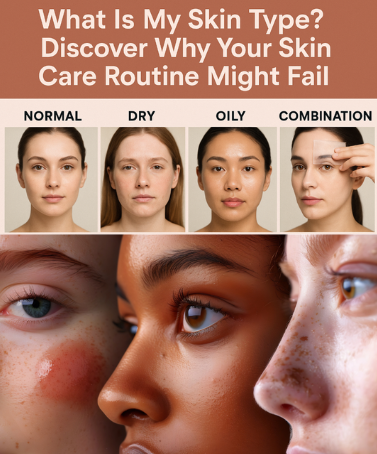
Ever spent hundreds of dollars on skincare products only to realize… nothing’s changing? The truth is, your skincare routine might be failing because you’re using products that don’t match your skin type. Just like you wouldn’t wear shoes that don’t fit, you shouldn’t use skincare that isn’t tailored to your unique skin needs. So, how do you figure out your skin type and finally get the glowing, healthy complexion you deserve? Let’s break it down.
Why Knowing Your Skin Type Matters
Think of your skin type as the blueprint for your skincare. If you don’t know the blueprint, every product you pick is just a gamble. Using a hydrating cream on already oily skin? You might clog your pores. Choosing a strong cleanser for sensitive skin? Hello, redness and irritation. When you know your skin type, you’re not just guessing—you’re treating your skin with precision.
How to Identify Your Skin Type at Home
While dermatologists can give you an expert diagnosis, you don’t need to book an appointment to figure out your skin type. There are two simple at-home methods you can try:
The Bare-Face Test
- Wash your face with a gentle cleanser.
- Pat it dry and leave it bare—no products, no moisturizer.
- After 30 minutes, check the mirror.
- Normal skin: Balanced, smooth, no dry patches or shiny spots.
- Dry skin: Feels tight, looks flaky or dull.
- Oily skin: Noticeable shine and greasy texture.
- Combination skin: Oily in the T-zone (forehead and nose), dry on cheeks.
- Sensitive skin: Red, itchy, or easily irritated.
The Blotting Sheet Test
- Take blotting paper and gently press it on different areas of your face.
- Hold it up to the light.
- Normal skin: Small amounts of oil appear.
- Dry skin: Almost no oil shows up.
- Oily skin: Heavy oil marks on most of the sheet.
- Combination skin: Oil in the T-zone only.
These tests aren’t perfect, but they’ll give you a solid starting point.
Normal Skin: The Balanced Beauty
If you’ve got normal skin, lucky you! It’s like hitting the skincare jackpot. Normal skin is well-balanced—neither too oily nor too dry.
Signs of normal skin:
- Fine pores
- Even tone and smooth texture
- Minimal sensitivity
Care tips: Stick with a gentle cleanser, lightweight moisturizer, and daily sunscreen. Don’t overload your skin with too many products—it’s already doing great.
Video : My Evidence-Based Skincare Routine
Dry Skin: The Thirsty Complexion
Dry skin produces less natural oil (sebum), leaving it vulnerable to flakiness, irritation, and tightness.
Signs of dry skin:
- Tight feeling after cleansing
- Rough or scaly texture
- Dull or uneven complexion
Care tips: Hydration is your best friend. Use creamy cleansers, rich moisturizers, and hydrating serums with hyaluronic acid. Avoid long hot showers—they strip your skin of essential oils.
Oily Skin: The Shine Factor
Oily skin often results from overactive sebaceous glands. Genetics, hormones, and even diet can all play a role.
Signs of oily skin:
- Shiny, greasy appearance
- Enlarged pores
- Frequent blackheads and breakouts
Care tips: Use oil-free cleansers, lightweight moisturizers, and non-comedogenic products. Exfoliate gently to keep pores clear. And don’t skip moisturizer—hydration balances oil production.
Combination Skin: The Best of Both Worlds (and the Worst)
Combination skin can feel like a juggling act—dry cheeks with an oily T-zone.
Signs of combination skin:
- Shiny forehead and nose
- Dry or tight cheeks
- Congested pores in oily areas
Care tips: Use a balancing routine. Try a gel cleanser, a lightweight moisturizer, and targeted treatments for oily spots. Sometimes, it’s best to use different products on different areas.
Sensitive Skin: The Delicate Type
Sensitive skin reacts quickly to harsh products, fragrances, and environmental changes.
Signs of sensitive skin:
- Redness or flushing
- Itching or burning sensations
- Easily irritated by new products
Care tips: Stick to fragrance-free and hypoallergenic formulas. Look for calming ingredients like aloe vera, oatmeal, and chamomile. Less is more—don’t overload sensitive skin.
Other Skin Concerns You Might Face
Even if you know your skin type, you could still face extra challenges:
- Acne-prone skin: Can affect any type, often triggered by excess oil, hormones, or diet.
- Dehydrated skin: Different from dry skin—this means your skin lacks water, not oil. Symptoms include dullness, fine lines, and tightness.
Both conditions can layer on top of your main skin type, making a tailored routine even more important.
Building the Right Skincare Routine for Your Skin Type
Here’s a quick cheat sheet:
- Normal skin: Gentle cleanser, lightweight moisturizer, broad-spectrum SPF.
- Dry skin: Creamy cleansers, rich moisturizers, hydrating masks.
- Oily skin: Foaming cleanser, oil-free moisturizer, clay masks.
- Combination skin: Gel cleanser, balancing toner, targeted spot care.
- Sensitive skin: Mild cleanser, soothing moisturizer, mineral sunscreen.
Video : Teenage skin care | dermatologist recommends
Conclusion: Know Your Skin, Love Your Skin
Your skincare routine isn’t failing you—it’s just mismatched. When you know your true skin type, you unlock the key to products that actually work. Think of it like customizing your morning coffee order—get it right, and everything feels better. So, ditch the one-size-fits-all approach, do a quick skin type test at home, and start building a routine that finally gives you the results you’ve been chasing.


